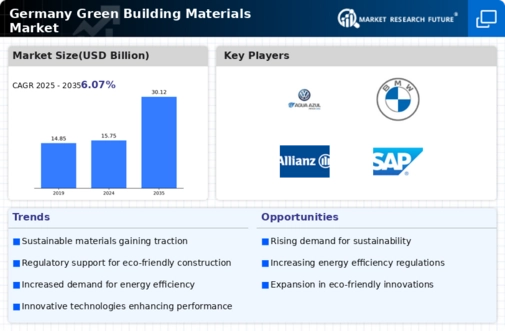Rising Environmental Awareness
The green building materials market in Germany experiences a notable boost due to increasing environmental awareness among consumers and businesses. As individuals become more conscious of their ecological footprint, there is a growing preference for sustainable construction practices. This shift is reflected in the rising demand for eco-friendly materials, which are perceived as essential for reducing carbon emissions and conserving natural resources. In 2023, approximately 60% of construction projects in Germany incorporated some form of sustainable materials, indicating a significant trend towards greener building practices. This heightened awareness not only influences purchasing decisions but also drives innovation within the green building-materials market, as manufacturers strive to meet the evolving expectations of environmentally conscious consumers.
Stringent Building Regulations
The regulatory landscape in Germany significantly impacts the green building materials market. Stricter building codes and standards aimed at reducing energy consumption and promoting sustainability have been established. The Energy Saving Ordinance (EnEV) mandates that new buildings meet specific energy efficiency criteria, which often necessitates the use of green materials. As of 2025, it is estimated that compliance with these regulations will drive a 20% increase in the demand for sustainable building materials. This regulatory pressure compels architects and builders to prioritize eco-friendly options, thereby fostering growth within the green building-materials market. The alignment of regulations with sustainability goals further solidifies the market's trajectory towards greener solutions.
Consumer Preference for Energy Efficiency
Consumer preferences are increasingly leaning towards energy-efficient solutions, which significantly influences the green building materials market in Germany. Homebuyers and businesses alike are prioritizing properties that offer lower energy consumption and reduced utility costs. This trend is evident in the rising popularity of materials that enhance insulation and energy performance. In 2025, it is projected that energy-efficient building materials will account for over 30% of the total market share. This shift in consumer behavior not only drives demand for innovative green materials but also encourages manufacturers to invest in research and development to create products that meet these energy efficiency standards. The alignment of consumer preferences with sustainability goals is likely to propel the growth of the green building-materials market.
Economic Incentives for Sustainable Construction
Economic incentives play a crucial role in shaping the green building materials market in Germany. The government has implemented various financial mechanisms, such as grants and tax reductions, to encourage the adoption of sustainable building practices. For instance, the KfW Bank offers low-interest loans for energy-efficient renovations, which has led to a marked increase in the use of green materials. In 2024, it is projected that the market for green building materials will grow by 15% as a direct result of these incentives. This financial support not only lowers the initial investment barrier for builders but also promotes long-term savings through reduced energy costs, thereby enhancing the attractiveness of green building materials.
Technological Innovations in Material Production
Technological advancements in the production of building materials are reshaping the green building materials market in Germany. Innovations such as the development of bio-based materials and improved recycling processes are enhancing the sustainability of construction products. For example, the introduction of materials made from recycled plastics and agricultural waste is gaining traction, appealing to environmentally conscious consumers. In 2025, it is anticipated that these innovations will contribute to a 10% increase in the market share of green materials. The integration of technology not only improves the performance and durability of these materials but also reduces their environmental impact, thereby aligning with the growing demand for sustainable construction solutions.















Leave a Comment